Individual Report: Communication Analysis at Brit-Tech (CFPBUS004)
VerifiedAdded on 2022/05/09
|13
|2170
|29
Report
AI Summary
This individual report, prepared for the CFPBUS004 Business Communication course, analyzes the communication challenges faced by Brit-Tech, a company transitioning to a hybrid work model. The report begins with an abstract highlighting the communication difficulties arising from the company's shift and the subsequent employee reluctance to return to the office. It provides an overview of organizational communication, exploring general theories such as modern, naturalistic, and critical theories. The core of the report identifies various barriers to communication within Brit-Tech, including cultural, physical, emotional, and interpersonal issues. To address these challenges, the report proposes strategies such as active listening, mental health counselor assistance, elimination of distractions, and cultural exchanges. Furthermore, it recommends enabling a disturbance-free workplace, maintaining clear communication channels, and fostering a flat hierarchical approach to enhance employee confidence and communication. The report concludes by emphasizing the importance of clear communication in building a strong organizational reputation and suggests continuous identification of communication barriers for sustained improvement. The report references key academic sources to support its analysis and recommendations.
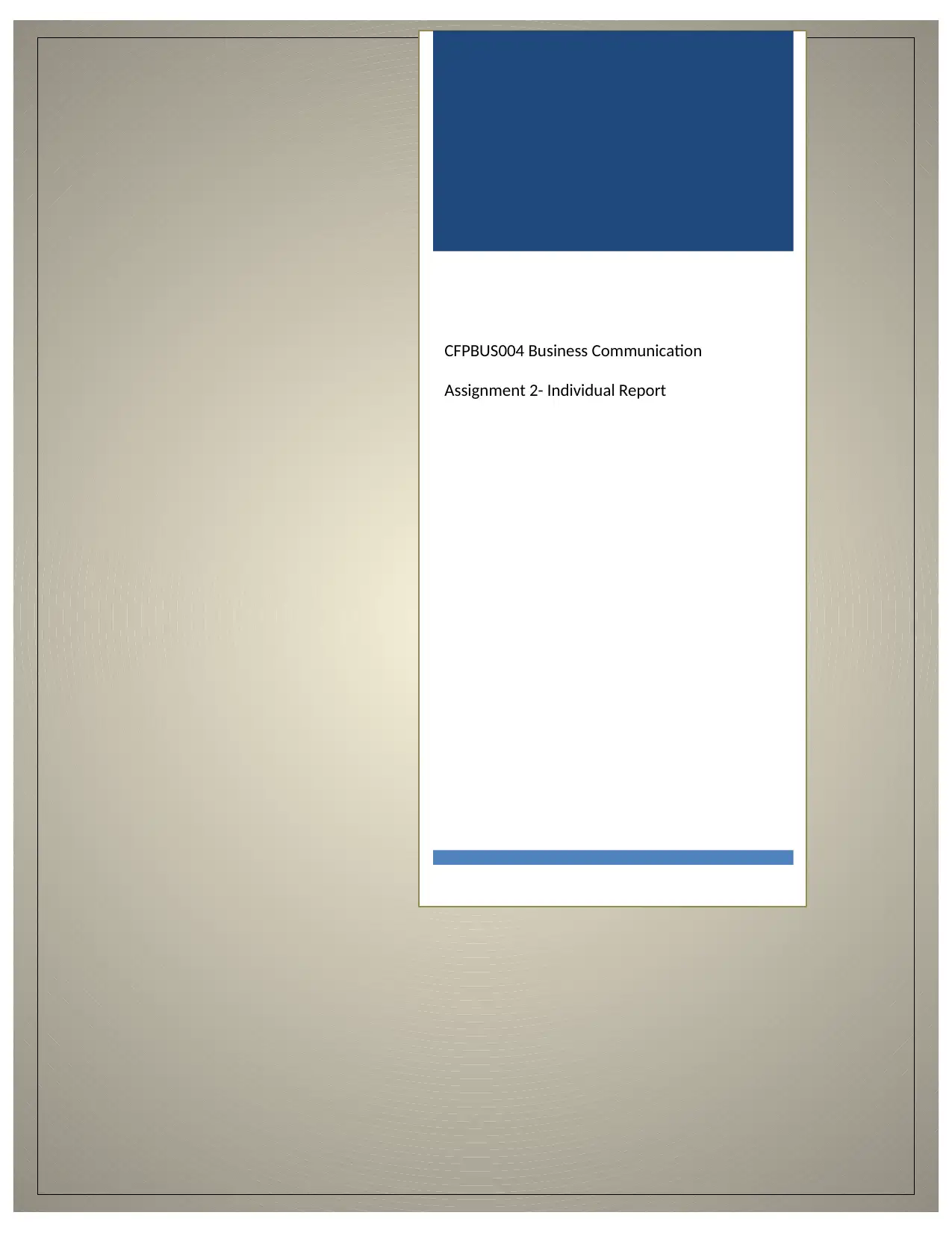
CFPBUS004 Business Communication
Assignment 2- Individual Report
Assignment 2- Individual Report
Paraphrase This Document
Need a fresh take? Get an instant paraphrase of this document with our AI Paraphraser
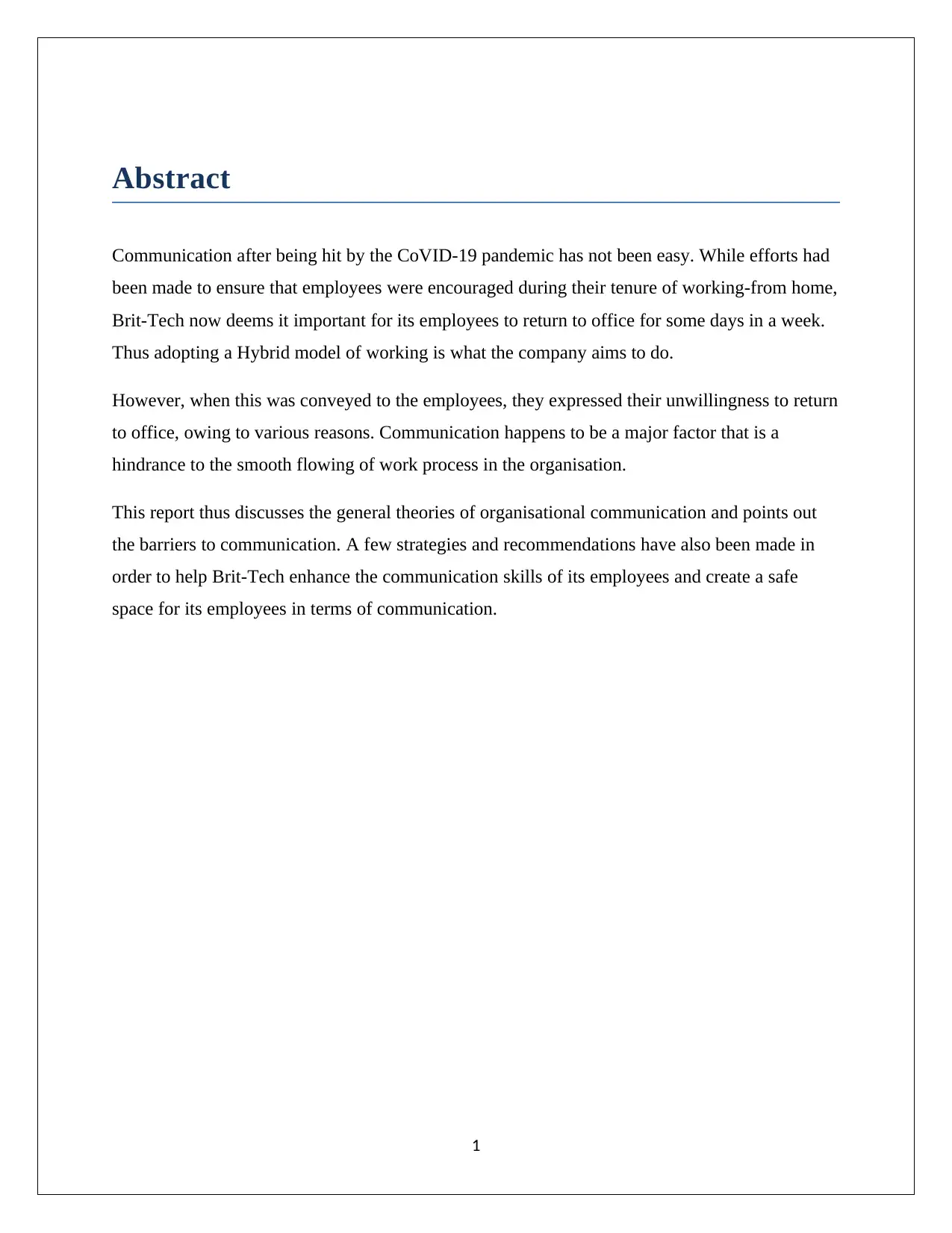
Abstract
Communication after being hit by the CoVID-19 pandemic has not been easy. While efforts had
been made to ensure that employees were encouraged during their tenure of working-from home,
Brit-Tech now deems it important for its employees to return to office for some days in a week.
Thus adopting a Hybrid model of working is what the company aims to do.
However, when this was conveyed to the employees, they expressed their unwillingness to return
to office, owing to various reasons. Communication happens to be a major factor that is a
hindrance to the smooth flowing of work process in the organisation.
This report thus discusses the general theories of organisational communication and points out
the barriers to communication. A few strategies and recommendations have also been made in
order to help Brit-Tech enhance the communication skills of its employees and create a safe
space for its employees in terms of communication.
1
Communication after being hit by the CoVID-19 pandemic has not been easy. While efforts had
been made to ensure that employees were encouraged during their tenure of working-from home,
Brit-Tech now deems it important for its employees to return to office for some days in a week.
Thus adopting a Hybrid model of working is what the company aims to do.
However, when this was conveyed to the employees, they expressed their unwillingness to return
to office, owing to various reasons. Communication happens to be a major factor that is a
hindrance to the smooth flowing of work process in the organisation.
This report thus discusses the general theories of organisational communication and points out
the barriers to communication. A few strategies and recommendations have also been made in
order to help Brit-Tech enhance the communication skills of its employees and create a safe
space for its employees in terms of communication.
1
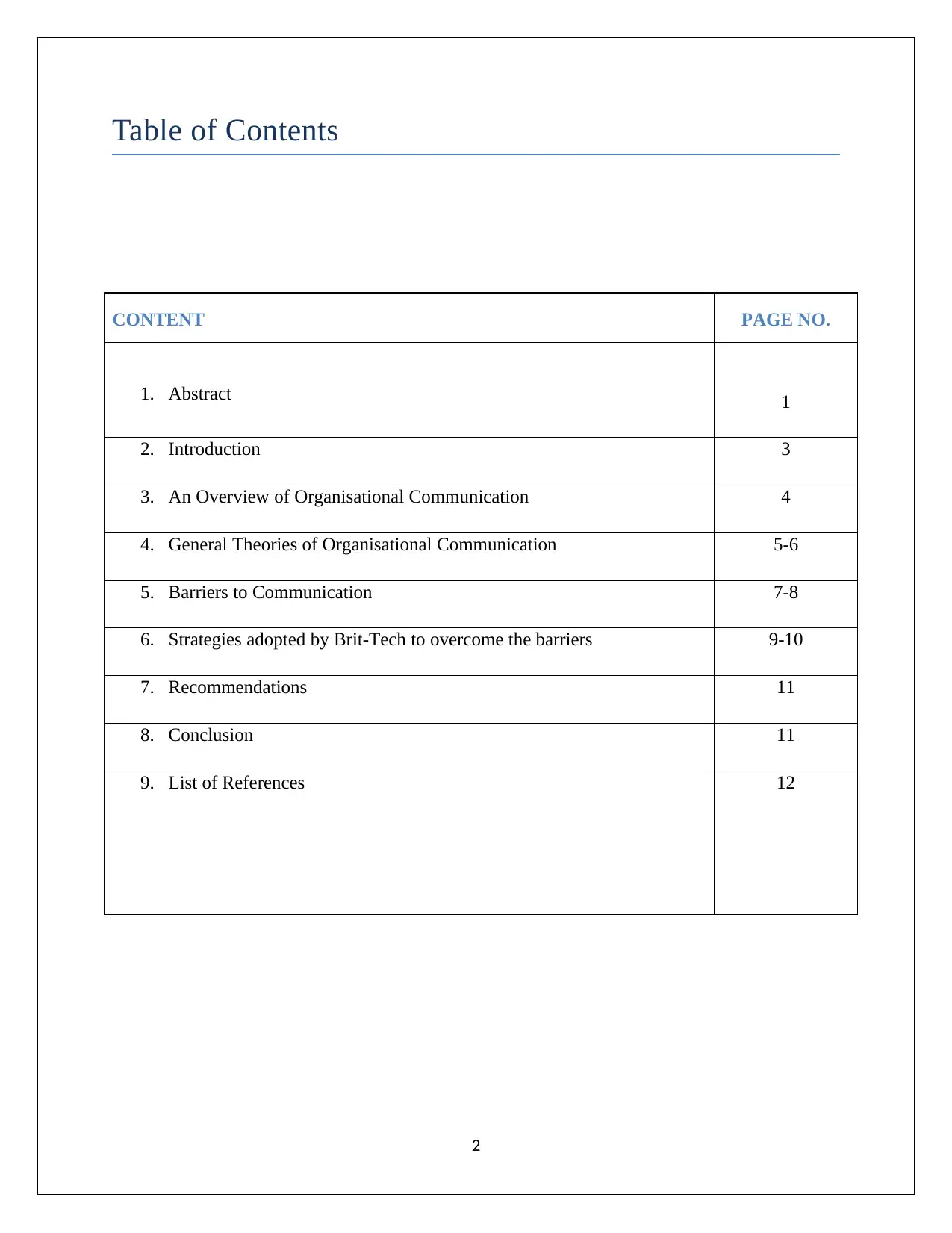
Table of Contents
CONTENT PAGE NO.
1. Abstract 1
2. Introduction 3
3. An Overview of Organisational Communication 4
4. General Theories of Organisational Communication 5-6
5. Barriers to Communication 7-8
6. Strategies adopted by Brit-Tech to overcome the barriers 9-10
7. Recommendations 11
8. Conclusion 11
9. List of References 12
2
CONTENT PAGE NO.
1. Abstract 1
2. Introduction 3
3. An Overview of Organisational Communication 4
4. General Theories of Organisational Communication 5-6
5. Barriers to Communication 7-8
6. Strategies adopted by Brit-Tech to overcome the barriers 9-10
7. Recommendations 11
8. Conclusion 11
9. List of References 12
2
⊘ This is a preview!⊘
Do you want full access?
Subscribe today to unlock all pages.

Trusted by 1+ million students worldwide
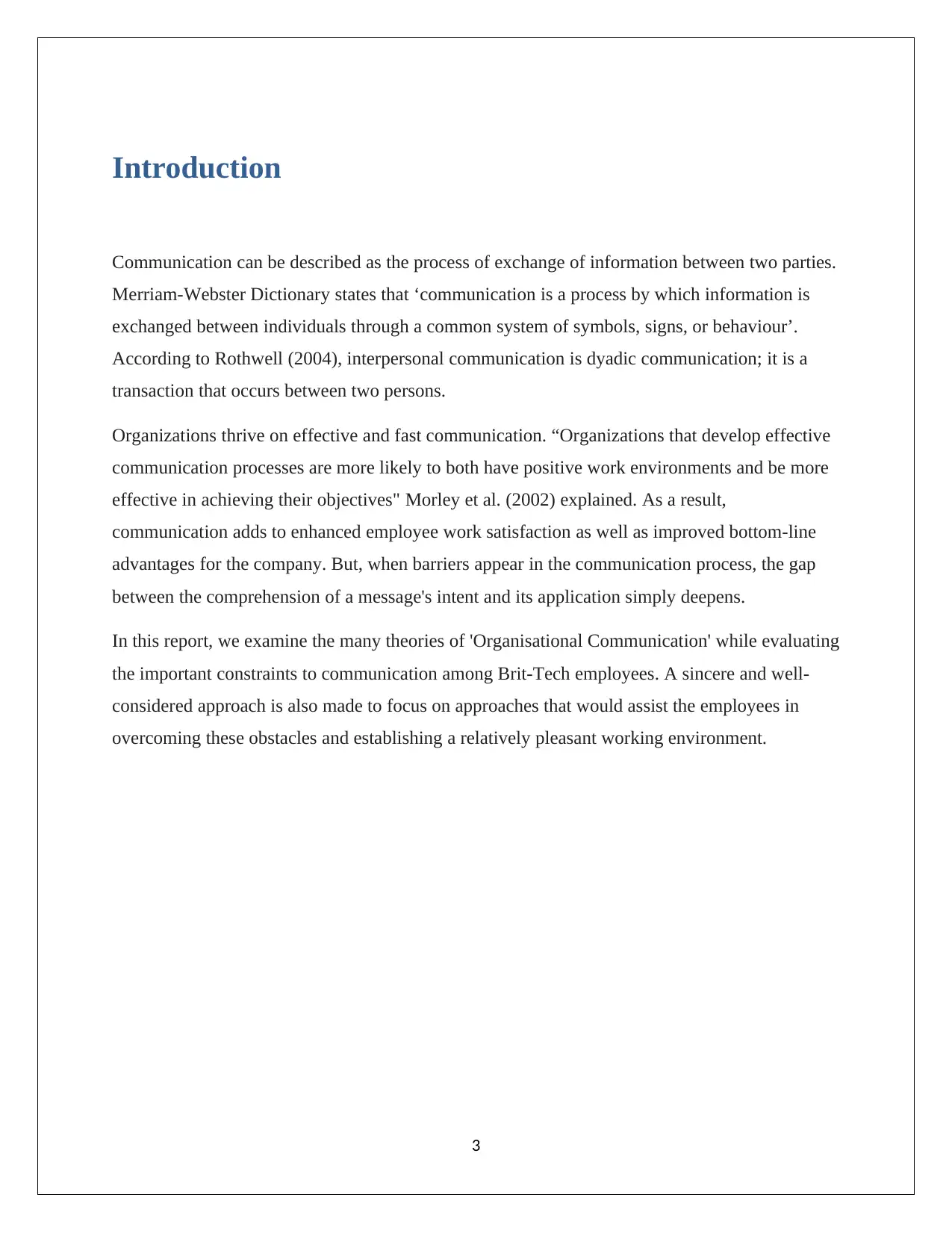
Introduction
Communication can be described as the process of exchange of information between two parties.
Merriam-Webster Dictionary states that ‘communication is a process by which information is
exchanged between individuals through a common system of symbols, signs, or behaviour’.
According to Rothwell (2004), interpersonal communication is dyadic communication; it is a
transaction that occurs between two persons.
Organizations thrive on effective and fast communication. “Organizations that develop effective
communication processes are more likely to both have positive work environments and be more
effective in achieving their objectives" Morley et al. (2002) explained. As a result,
communication adds to enhanced employee work satisfaction as well as improved bottom-line
advantages for the company. But, when barriers appear in the communication process, the gap
between the comprehension of a message's intent and its application simply deepens.
In this report, we examine the many theories of 'Organisational Communication' while evaluating
the important constraints to communication among Brit-Tech employees. A sincere and well-
considered approach is also made to focus on approaches that would assist the employees in
overcoming these obstacles and establishing a relatively pleasant working environment.
3
Communication can be described as the process of exchange of information between two parties.
Merriam-Webster Dictionary states that ‘communication is a process by which information is
exchanged between individuals through a common system of symbols, signs, or behaviour’.
According to Rothwell (2004), interpersonal communication is dyadic communication; it is a
transaction that occurs between two persons.
Organizations thrive on effective and fast communication. “Organizations that develop effective
communication processes are more likely to both have positive work environments and be more
effective in achieving their objectives" Morley et al. (2002) explained. As a result,
communication adds to enhanced employee work satisfaction as well as improved bottom-line
advantages for the company. But, when barriers appear in the communication process, the gap
between the comprehension of a message's intent and its application simply deepens.
In this report, we examine the many theories of 'Organisational Communication' while evaluating
the important constraints to communication among Brit-Tech employees. A sincere and well-
considered approach is also made to focus on approaches that would assist the employees in
overcoming these obstacles and establishing a relatively pleasant working environment.
3
Paraphrase This Document
Need a fresh take? Get an instant paraphrase of this document with our AI Paraphraser
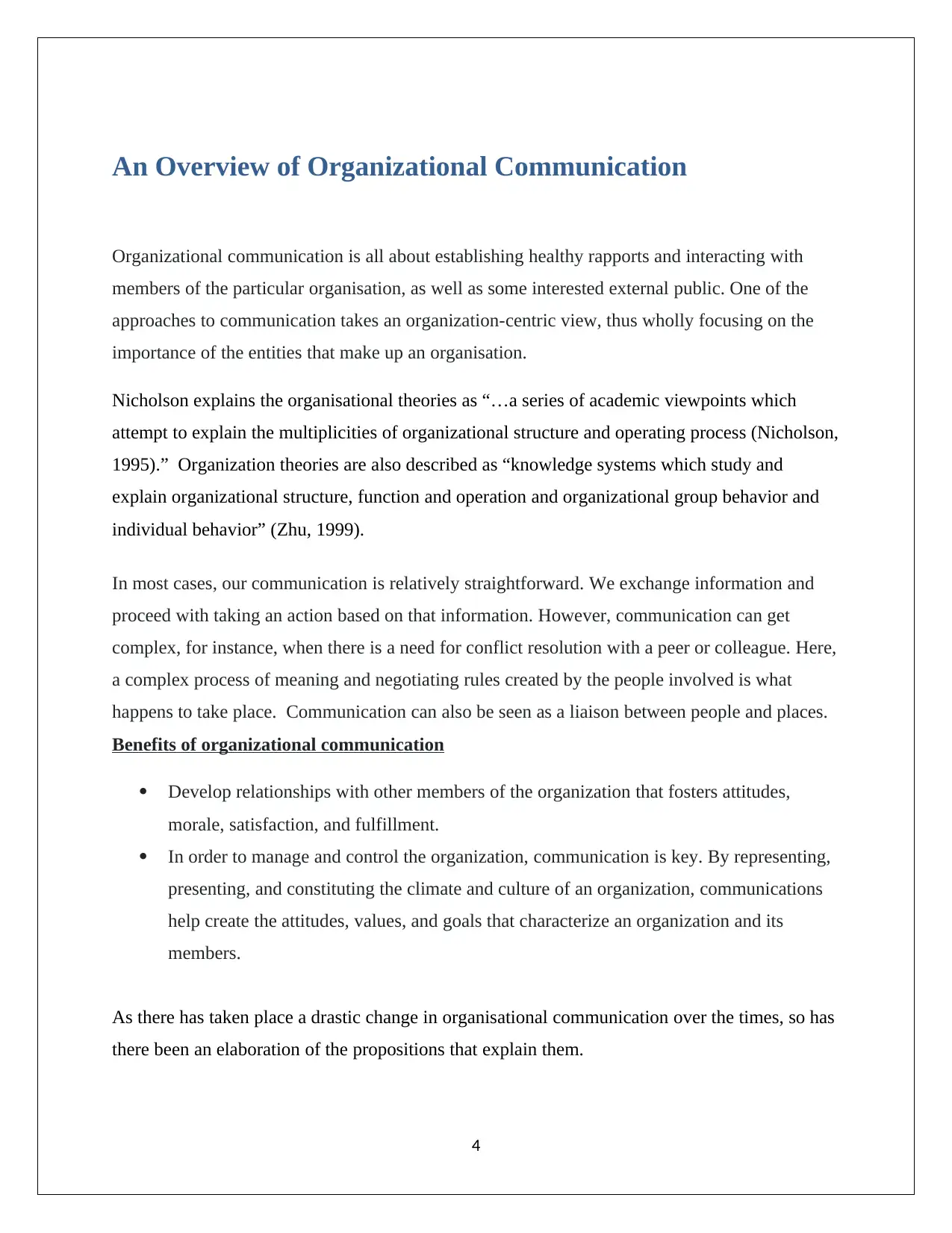
An Overview of Organizational Communication
Organizational communication is all about establishing healthy rapports and interacting with
members of the particular organisation, as well as some interested external public. One of the
approaches to communication takes an organization-centric view, thus wholly focusing on the
importance of the entities that make up an organisation.
Nicholson explains the organisational theories as “…a series of academic viewpoints which
attempt to explain the multiplicities of organizational structure and operating process (Nicholson,
1995).” Organization theories are also described as “knowledge systems which study and
explain organizational structure, function and operation and organizational group behavior and
individual behavior” (Zhu, 1999).
In most cases, our communication is relatively straightforward. We exchange information and
proceed with taking an action based on that information. However, communication can get
complex, for instance, when there is a need for conflict resolution with a peer or colleague. Here,
a complex process of meaning and negotiating rules created by the people involved is what
happens to take place. Communication can also be seen as a liaison between people and places.
Benefits of organizational communication
Develop relationships with other members of the organization that fosters attitudes,
morale, satisfaction, and fulfillment.
In order to manage and control the organization, communication is key. By representing,
presenting, and constituting the climate and culture of an organization, communications
help create the attitudes, values, and goals that characterize an organization and its
members.
As there has taken place a drastic change in organisational communication over the times, so has
there been an elaboration of the propositions that explain them.
4
Organizational communication is all about establishing healthy rapports and interacting with
members of the particular organisation, as well as some interested external public. One of the
approaches to communication takes an organization-centric view, thus wholly focusing on the
importance of the entities that make up an organisation.
Nicholson explains the organisational theories as “…a series of academic viewpoints which
attempt to explain the multiplicities of organizational structure and operating process (Nicholson,
1995).” Organization theories are also described as “knowledge systems which study and
explain organizational structure, function and operation and organizational group behavior and
individual behavior” (Zhu, 1999).
In most cases, our communication is relatively straightforward. We exchange information and
proceed with taking an action based on that information. However, communication can get
complex, for instance, when there is a need for conflict resolution with a peer or colleague. Here,
a complex process of meaning and negotiating rules created by the people involved is what
happens to take place. Communication can also be seen as a liaison between people and places.
Benefits of organizational communication
Develop relationships with other members of the organization that fosters attitudes,
morale, satisfaction, and fulfillment.
In order to manage and control the organization, communication is key. By representing,
presenting, and constituting the climate and culture of an organization, communications
help create the attitudes, values, and goals that characterize an organization and its
members.
As there has taken place a drastic change in organisational communication over the times, so has
there been an elaboration of the propositions that explain them.
4
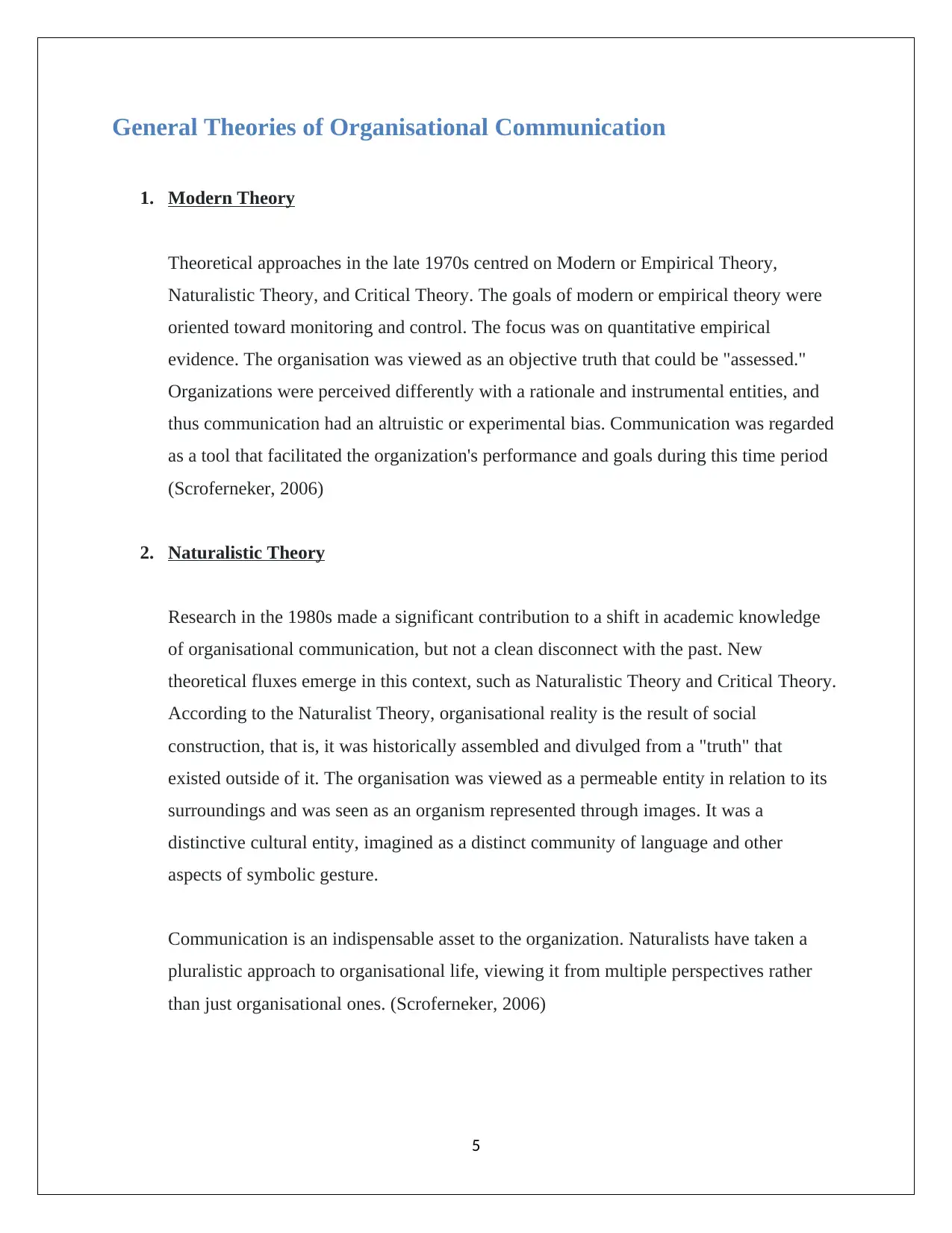
General Theories of Organisational Communication
1. Modern Theory
Theoretical approaches in the late 1970s centred on Modern or Empirical Theory,
Naturalistic Theory, and Critical Theory. The goals of modern or empirical theory were
oriented toward monitoring and control. The focus was on quantitative empirical
evidence. The organisation was viewed as an objective truth that could be "assessed."
Organizations were perceived differently with a rationale and instrumental entities, and
thus communication had an altruistic or experimental bias. Communication was regarded
as a tool that facilitated the organization's performance and goals during this time period
(Scroferneker, 2006)
2. Naturalistic Theory
Research in the 1980s made a significant contribution to a shift in academic knowledge
of organisational communication, but not a clean disconnect with the past. New
theoretical fluxes emerge in this context, such as Naturalistic Theory and Critical Theory.
According to the Naturalist Theory, organisational reality is the result of social
construction, that is, it was historically assembled and divulged from a "truth" that
existed outside of it. The organisation was viewed as a permeable entity in relation to its
surroundings and was seen as an organism represented through images. It was a
distinctive cultural entity, imagined as a distinct community of language and other
aspects of symbolic gesture.
Communication is an indispensable asset to the organization. Naturalists have taken a
pluralistic approach to organisational life, viewing it from multiple perspectives rather
than just organisational ones. (Scroferneker, 2006)
5
1. Modern Theory
Theoretical approaches in the late 1970s centred on Modern or Empirical Theory,
Naturalistic Theory, and Critical Theory. The goals of modern or empirical theory were
oriented toward monitoring and control. The focus was on quantitative empirical
evidence. The organisation was viewed as an objective truth that could be "assessed."
Organizations were perceived differently with a rationale and instrumental entities, and
thus communication had an altruistic or experimental bias. Communication was regarded
as a tool that facilitated the organization's performance and goals during this time period
(Scroferneker, 2006)
2. Naturalistic Theory
Research in the 1980s made a significant contribution to a shift in academic knowledge
of organisational communication, but not a clean disconnect with the past. New
theoretical fluxes emerge in this context, such as Naturalistic Theory and Critical Theory.
According to the Naturalist Theory, organisational reality is the result of social
construction, that is, it was historically assembled and divulged from a "truth" that
existed outside of it. The organisation was viewed as a permeable entity in relation to its
surroundings and was seen as an organism represented through images. It was a
distinctive cultural entity, imagined as a distinct community of language and other
aspects of symbolic gesture.
Communication is an indispensable asset to the organization. Naturalists have taken a
pluralistic approach to organisational life, viewing it from multiple perspectives rather
than just organisational ones. (Scroferneker, 2006)
5
⊘ This is a preview!⊘
Do you want full access?
Subscribe today to unlock all pages.

Trusted by 1+ million students worldwide
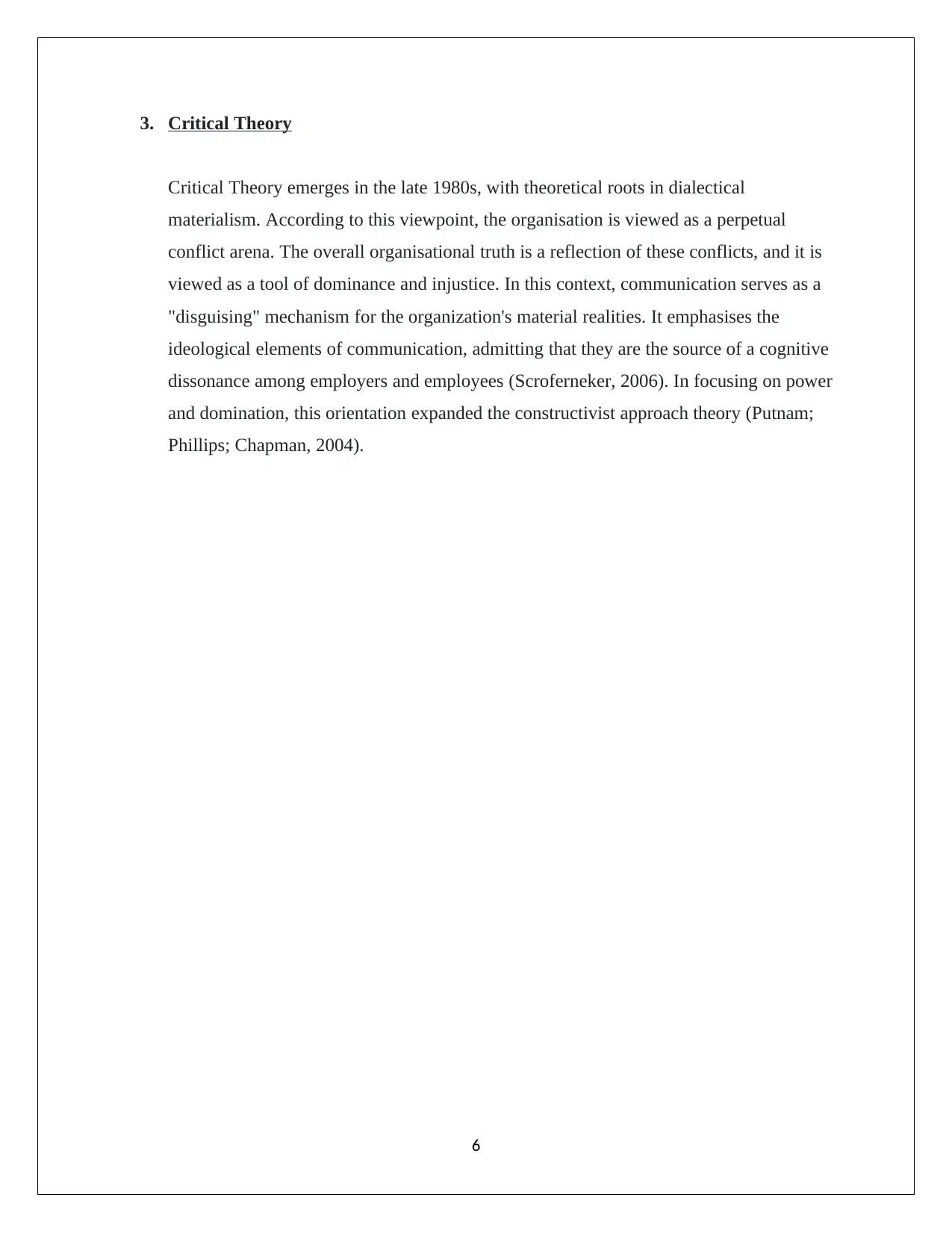
3. Critical Theory
Critical Theory emerges in the late 1980s, with theoretical roots in dialectical
materialism. According to this viewpoint, the organisation is viewed as a perpetual
conflict arena. The overall organisational truth is a reflection of these conflicts, and it is
viewed as a tool of dominance and injustice. In this context, communication serves as a
"disguising" mechanism for the organization's material realities. It emphasises the
ideological elements of communication, admitting that they are the source of a cognitive
dissonance among employers and employees (Scroferneker, 2006). In focusing on power
and domination, this orientation expanded the constructivist approach theory (Putnam;
Phillips; Chapman, 2004).
6
Critical Theory emerges in the late 1980s, with theoretical roots in dialectical
materialism. According to this viewpoint, the organisation is viewed as a perpetual
conflict arena. The overall organisational truth is a reflection of these conflicts, and it is
viewed as a tool of dominance and injustice. In this context, communication serves as a
"disguising" mechanism for the organization's material realities. It emphasises the
ideological elements of communication, admitting that they are the source of a cognitive
dissonance among employers and employees (Scroferneker, 2006). In focusing on power
and domination, this orientation expanded the constructivist approach theory (Putnam;
Phillips; Chapman, 2004).
6
Paraphrase This Document
Need a fresh take? Get an instant paraphrase of this document with our AI Paraphraser
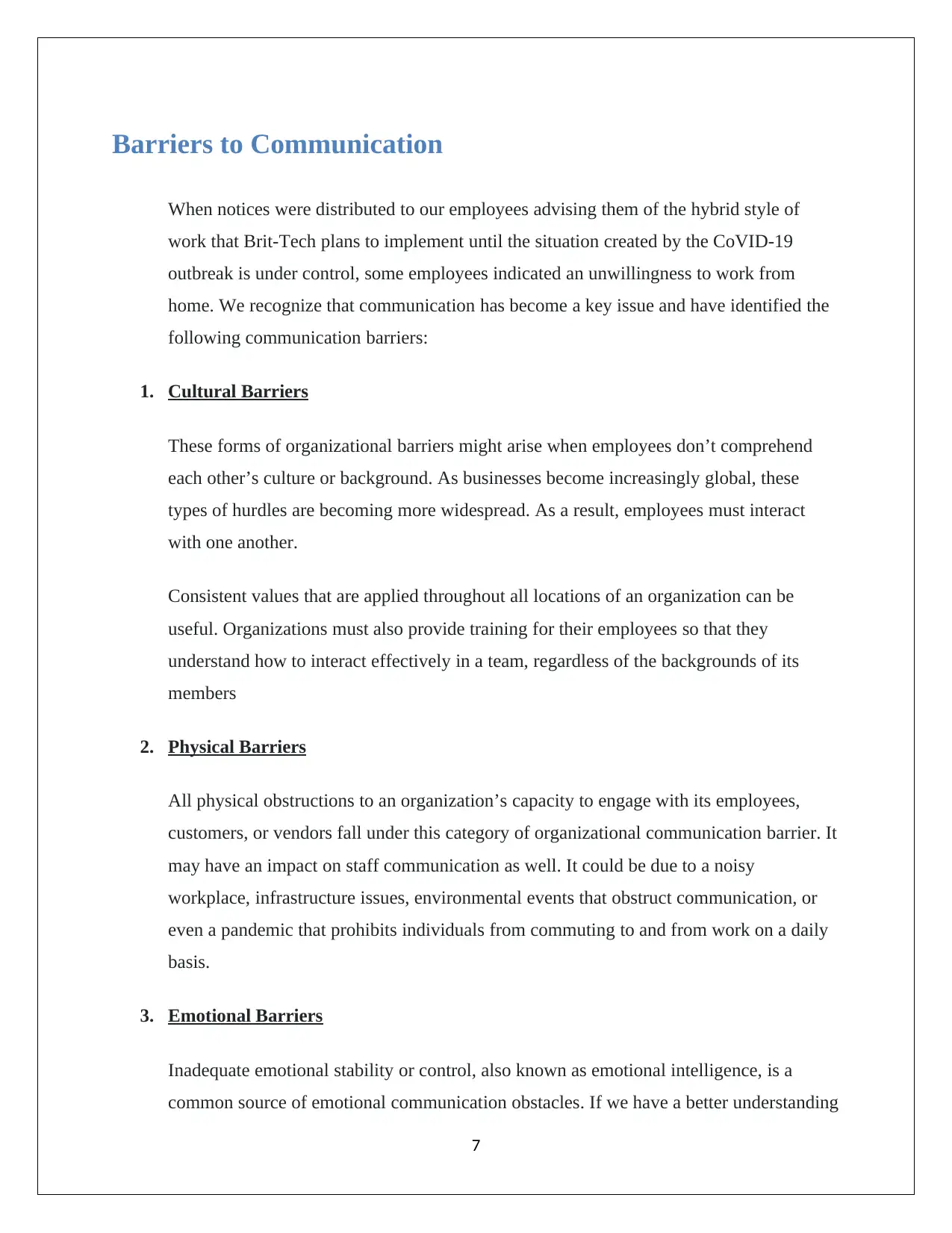
Barriers to Communication
When notices were distributed to our employees advising them of the hybrid style of
work that Brit-Tech plans to implement until the situation created by the CoVID-19
outbreak is under control, some employees indicated an unwillingness to work from
home. We recognize that communication has become a key issue and have identified the
following communication barriers:
1. Cultural Barriers
These forms of organizational barriers might arise when employees don’t comprehend
each other’s culture or background. As businesses become increasingly global, these
types of hurdles are becoming more widespread. As a result, employees must interact
with one another.
Consistent values that are applied throughout all locations of an organization can be
useful. Organizations must also provide training for their employees so that they
understand how to interact effectively in a team, regardless of the backgrounds of its
members
2. Physical Barriers
All physical obstructions to an organization’s capacity to engage with its employees,
customers, or vendors fall under this category of organizational communication barrier. It
may have an impact on staff communication as well. It could be due to a noisy
workplace, infrastructure issues, environmental events that obstruct communication, or
even a pandemic that prohibits individuals from commuting to and from work on a daily
basis.
3. Emotional Barriers
Inadequate emotional stability or control, also known as emotional intelligence, is a
common source of emotional communication obstacles. If we have a better understanding
7
When notices were distributed to our employees advising them of the hybrid style of
work that Brit-Tech plans to implement until the situation created by the CoVID-19
outbreak is under control, some employees indicated an unwillingness to work from
home. We recognize that communication has become a key issue and have identified the
following communication barriers:
1. Cultural Barriers
These forms of organizational barriers might arise when employees don’t comprehend
each other’s culture or background. As businesses become increasingly global, these
types of hurdles are becoming more widespread. As a result, employees must interact
with one another.
Consistent values that are applied throughout all locations of an organization can be
useful. Organizations must also provide training for their employees so that they
understand how to interact effectively in a team, regardless of the backgrounds of its
members
2. Physical Barriers
All physical obstructions to an organization’s capacity to engage with its employees,
customers, or vendors fall under this category of organizational communication barrier. It
may have an impact on staff communication as well. It could be due to a noisy
workplace, infrastructure issues, environmental events that obstruct communication, or
even a pandemic that prohibits individuals from commuting to and from work on a daily
basis.
3. Emotional Barriers
Inadequate emotional stability or control, also known as emotional intelligence, is a
common source of emotional communication obstacles. If we have a better understanding
7
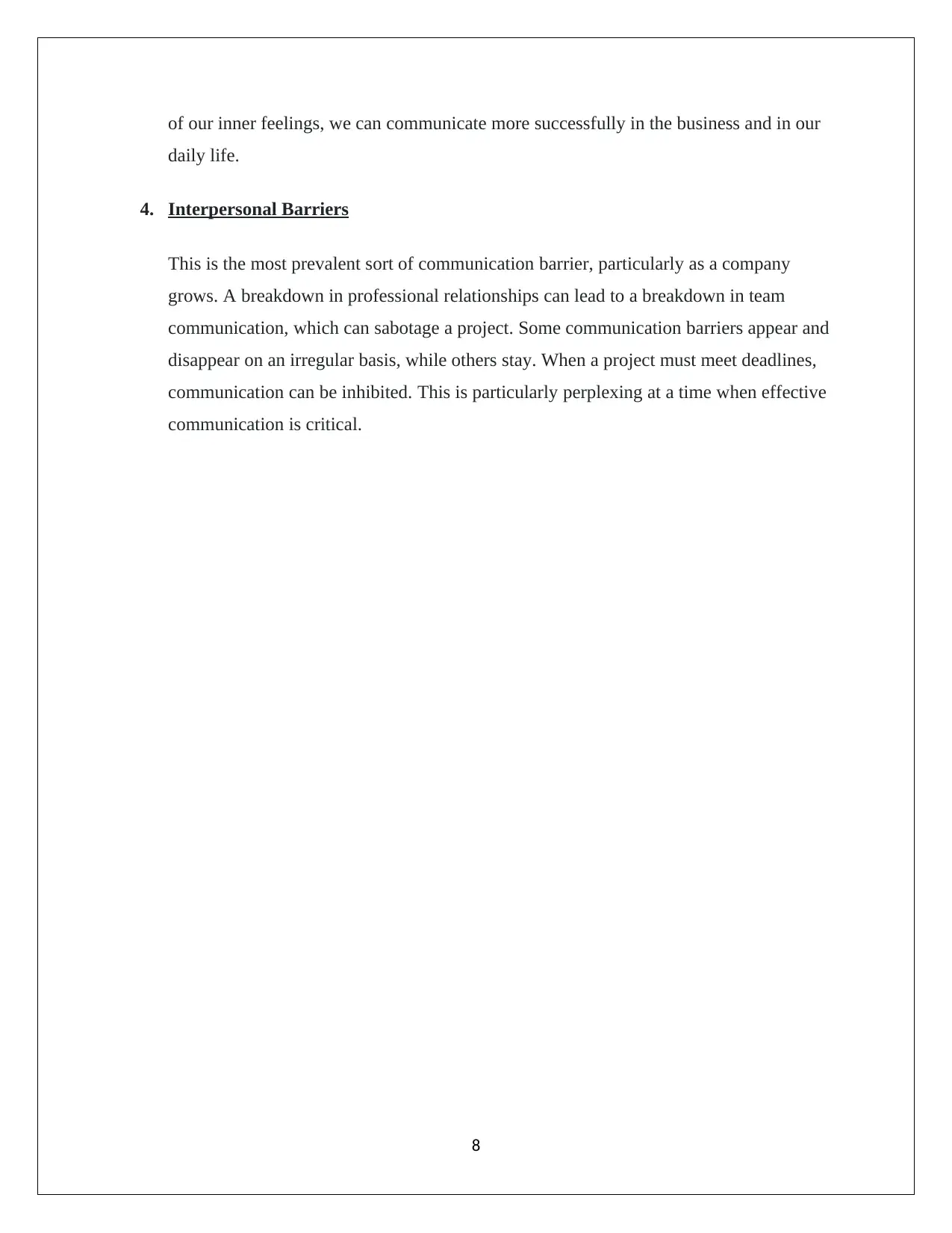
of our inner feelings, we can communicate more successfully in the business and in our
daily life.
4. Interpersonal Barriers
This is the most prevalent sort of communication barrier, particularly as a company
grows. A breakdown in professional relationships can lead to a breakdown in team
communication, which can sabotage a project. Some communication barriers appear and
disappear on an irregular basis, while others stay. When a project must meet deadlines,
communication can be inhibited. This is particularly perplexing at a time when effective
communication is critical.
8
daily life.
4. Interpersonal Barriers
This is the most prevalent sort of communication barrier, particularly as a company
grows. A breakdown in professional relationships can lead to a breakdown in team
communication, which can sabotage a project. Some communication barriers appear and
disappear on an irregular basis, while others stay. When a project must meet deadlines,
communication can be inhibited. This is particularly perplexing at a time when effective
communication is critical.
8
⊘ This is a preview!⊘
Do you want full access?
Subscribe today to unlock all pages.

Trusted by 1+ million students worldwide
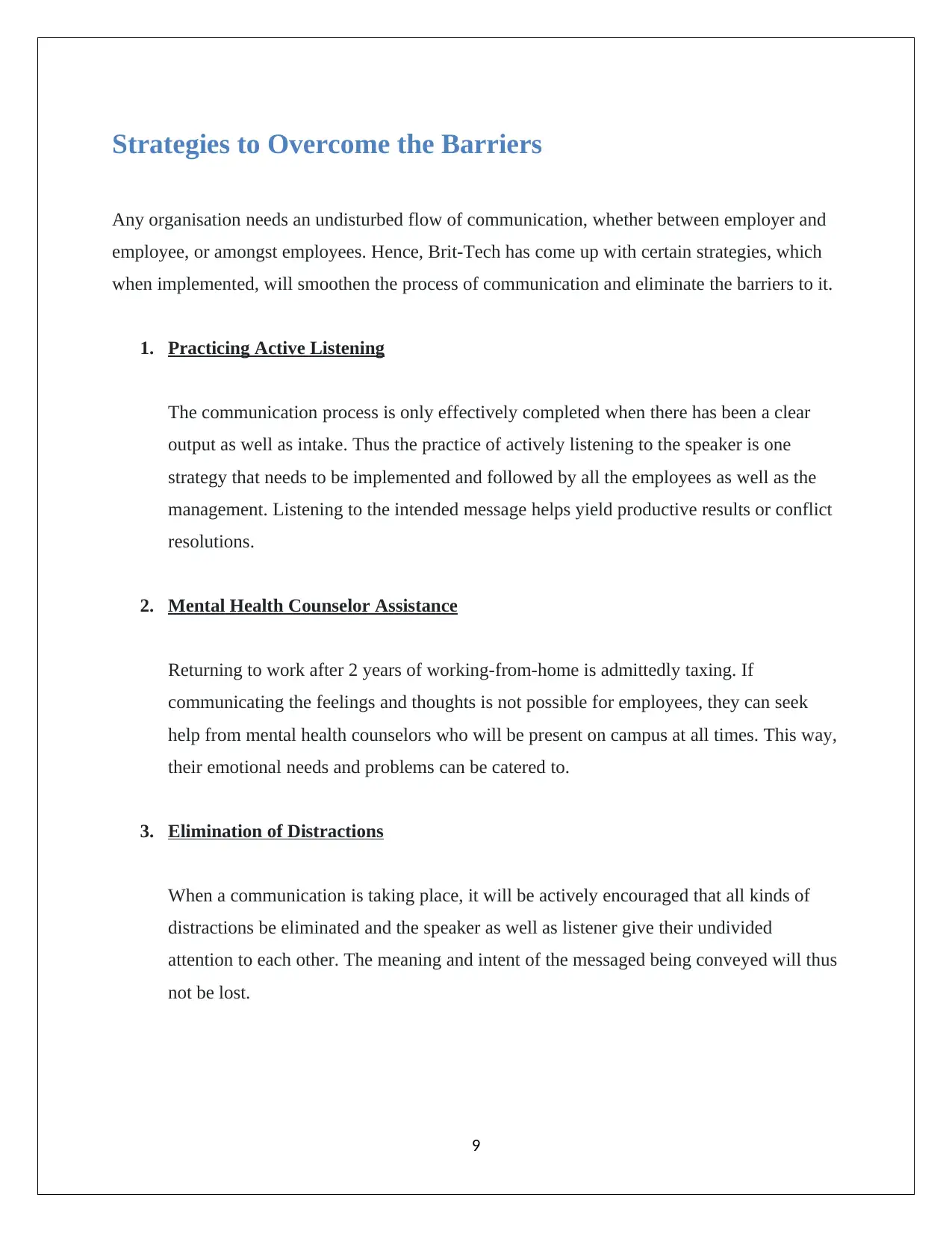
Strategies to Overcome the Barriers
Any organisation needs an undisturbed flow of communication, whether between employer and
employee, or amongst employees. Hence, Brit-Tech has come up with certain strategies, which
when implemented, will smoothen the process of communication and eliminate the barriers to it.
1. Practicing Active Listening
The communication process is only effectively completed when there has been a clear
output as well as intake. Thus the practice of actively listening to the speaker is one
strategy that needs to be implemented and followed by all the employees as well as the
management. Listening to the intended message helps yield productive results or conflict
resolutions.
2. Mental Health Counselor Assistance
Returning to work after 2 years of working-from-home is admittedly taxing. If
communicating the feelings and thoughts is not possible for employees, they can seek
help from mental health counselors who will be present on campus at all times. This way,
their emotional needs and problems can be catered to.
3. Elimination of Distractions
When a communication is taking place, it will be actively encouraged that all kinds of
distractions be eliminated and the speaker as well as listener give their undivided
attention to each other. The meaning and intent of the messaged being conveyed will thus
not be lost.
9
Any organisation needs an undisturbed flow of communication, whether between employer and
employee, or amongst employees. Hence, Brit-Tech has come up with certain strategies, which
when implemented, will smoothen the process of communication and eliminate the barriers to it.
1. Practicing Active Listening
The communication process is only effectively completed when there has been a clear
output as well as intake. Thus the practice of actively listening to the speaker is one
strategy that needs to be implemented and followed by all the employees as well as the
management. Listening to the intended message helps yield productive results or conflict
resolutions.
2. Mental Health Counselor Assistance
Returning to work after 2 years of working-from-home is admittedly taxing. If
communicating the feelings and thoughts is not possible for employees, they can seek
help from mental health counselors who will be present on campus at all times. This way,
their emotional needs and problems can be catered to.
3. Elimination of Distractions
When a communication is taking place, it will be actively encouraged that all kinds of
distractions be eliminated and the speaker as well as listener give their undivided
attention to each other. The meaning and intent of the messaged being conveyed will thus
not be lost.
9
Paraphrase This Document
Need a fresh take? Get an instant paraphrase of this document with our AI Paraphraser
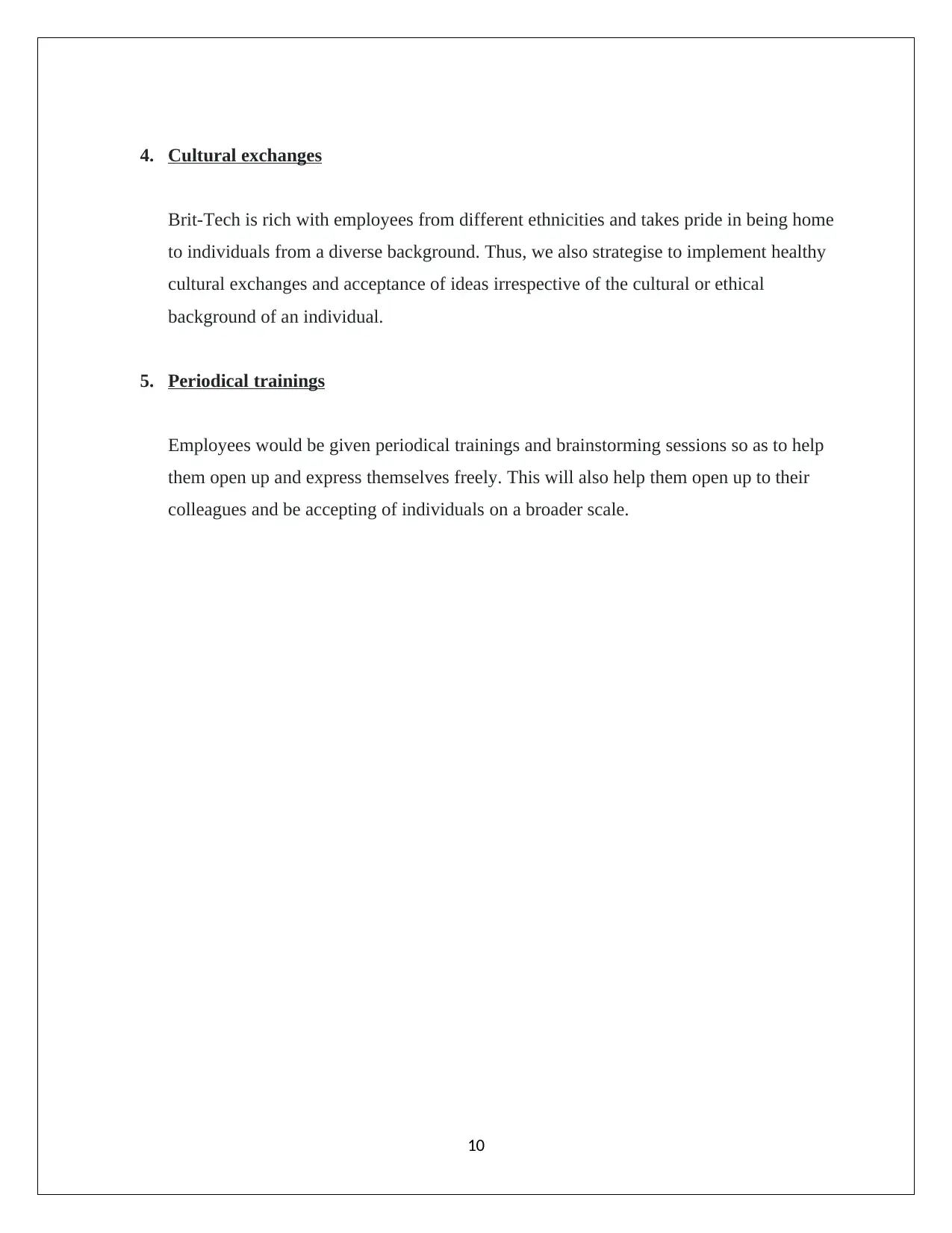
4. Cultural exchanges
Brit-Tech is rich with employees from different ethnicities and takes pride in being home
to individuals from a diverse background. Thus, we also strategise to implement healthy
cultural exchanges and acceptance of ideas irrespective of the cultural or ethical
background of an individual.
5. Periodical trainings
Employees would be given periodical trainings and brainstorming sessions so as to help
them open up and express themselves freely. This will also help them open up to their
colleagues and be accepting of individuals on a broader scale.
10
Brit-Tech is rich with employees from different ethnicities and takes pride in being home
to individuals from a diverse background. Thus, we also strategise to implement healthy
cultural exchanges and acceptance of ideas irrespective of the cultural or ethical
background of an individual.
5. Periodical trainings
Employees would be given periodical trainings and brainstorming sessions so as to help
them open up and express themselves freely. This will also help them open up to their
colleagues and be accepting of individuals on a broader scale.
10
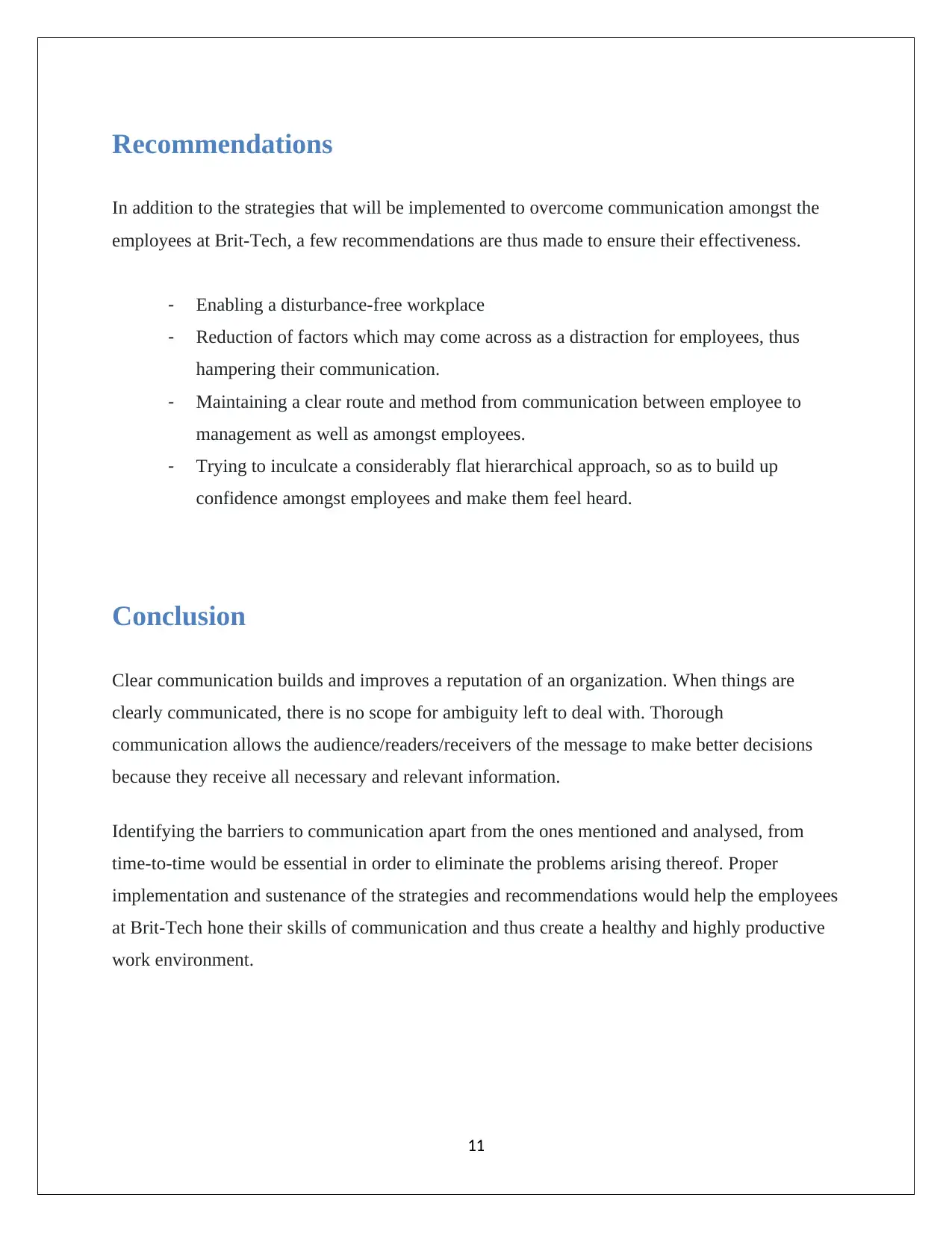
Recommendations
In addition to the strategies that will be implemented to overcome communication amongst the
employees at Brit-Tech, a few recommendations are thus made to ensure their effectiveness.
- Enabling a disturbance-free workplace
- Reduction of factors which may come across as a distraction for employees, thus
hampering their communication.
- Maintaining a clear route and method from communication between employee to
management as well as amongst employees.
- Trying to inculcate a considerably flat hierarchical approach, so as to build up
confidence amongst employees and make them feel heard.
Conclusion
Clear communication builds and improves a reputation of an organization. When things are
clearly communicated, there is no scope for ambiguity left to deal with. Thorough
communication allows the audience/readers/receivers of the message to make better decisions
because they receive all necessary and relevant information.
Identifying the barriers to communication apart from the ones mentioned and analysed, from
time-to-time would be essential in order to eliminate the problems arising thereof. Proper
implementation and sustenance of the strategies and recommendations would help the employees
at Brit-Tech hone their skills of communication and thus create a healthy and highly productive
work environment.
11
In addition to the strategies that will be implemented to overcome communication amongst the
employees at Brit-Tech, a few recommendations are thus made to ensure their effectiveness.
- Enabling a disturbance-free workplace
- Reduction of factors which may come across as a distraction for employees, thus
hampering their communication.
- Maintaining a clear route and method from communication between employee to
management as well as amongst employees.
- Trying to inculcate a considerably flat hierarchical approach, so as to build up
confidence amongst employees and make them feel heard.
Conclusion
Clear communication builds and improves a reputation of an organization. When things are
clearly communicated, there is no scope for ambiguity left to deal with. Thorough
communication allows the audience/readers/receivers of the message to make better decisions
because they receive all necessary and relevant information.
Identifying the barriers to communication apart from the ones mentioned and analysed, from
time-to-time would be essential in order to eliminate the problems arising thereof. Proper
implementation and sustenance of the strategies and recommendations would help the employees
at Brit-Tech hone their skills of communication and thus create a healthy and highly productive
work environment.
11
⊘ This is a preview!⊘
Do you want full access?
Subscribe today to unlock all pages.

Trusted by 1+ million students worldwide
1 out of 13
Related Documents
Your All-in-One AI-Powered Toolkit for Academic Success.
+13062052269
info@desklib.com
Available 24*7 on WhatsApp / Email
![[object Object]](/_next/static/media/star-bottom.7253800d.svg)
Unlock your academic potential
Copyright © 2020–2025 A2Z Services. All Rights Reserved. Developed and managed by ZUCOL.




